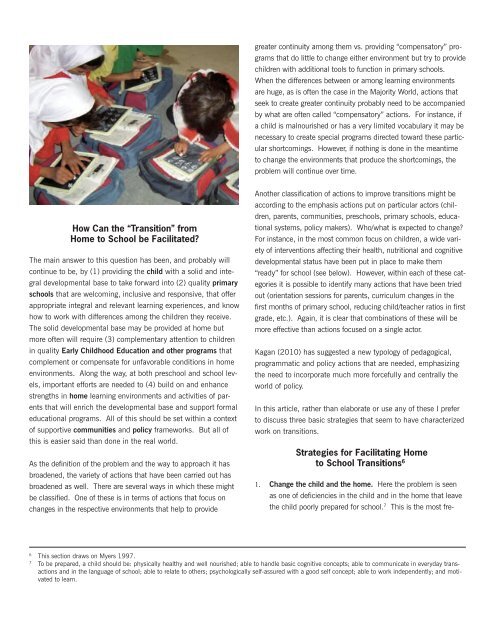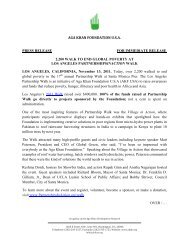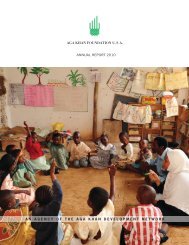2010 Annual Report: Education - PartnershipsInAction
2010 Annual Report: Education - PartnershipsInAction
2010 Annual Report: Education - PartnershipsInAction
You also want an ePaper? Increase the reach of your titles
YUMPU automatically turns print PDFs into web optimized ePapers that Google loves.
greater continuity among them vs. providing “compensatory” programs<br />
that do little to change either environment but try to provide<br />
children with additional tools to function in primary schools.<br />
When the differences between or among learning environments<br />
are huge, as is often the case in the Majority World, actions that<br />
seek to create greater continuity probably need to be accompanied<br />
by what are often called “compensatory” actions. For instance, if<br />
a child is malnourished or has a very limited vocabulary it may be<br />
necessary to create special programs directed toward these particular<br />
shortcomings. However, if nothing is done in the meantime<br />
to change the environments that produce the shortcomings, the<br />
problem will continue over time.<br />
How Can the “Transition” from<br />
Home to School be Facilitated<br />
The main answer to this question has been, and probably will<br />
continue to be, by (1) providing the child with a solid and integral<br />
developmental base to take forward into (2) quality primary<br />
schools that are welcoming, inclusive and responsive, that offer<br />
appropriate integral and relevant learning experiences, and know<br />
how to work with differences among the children they receive.<br />
The solid developmental base may be provided at home but<br />
more often will require (3) complementary attention to children<br />
in quality Early Childhood <strong>Education</strong> and other programs that<br />
complement or compensate for unfavorable conditions in home<br />
environments. Along the way, at both preschool and school levels,<br />
important efforts are needed to (4) build on and enhance<br />
strengths in home learning environments and activities of parents<br />
that will enrich the developmental base and support formal<br />
educational programs. All of this should be set within a context<br />
of supportive communities and policy frameworks. But all of<br />
this is easier said than done in the real world.<br />
As the definition of the problem and the way to approach it has<br />
broadened, the variety of actions that have been carried out has<br />
broadened as well. There are several ways in which these might<br />
be classified. One of these is in terms of actions that focus on<br />
changes in the respective environments that help to provide<br />
Another classification of actions to improve transitions might be<br />
according to the emphasis actions put on particular actors (children,<br />
parents, communities, preschools, primary schools, educational<br />
systems, policy makers). Who/what is expected to change<br />
For instance, in the most common focus on children, a wide variety<br />
of interventions affecting their health, nutritional and cognitive<br />
developmental status have been put in place to make them<br />
“ready” for school (see below). However, within each of these categories<br />
it is possible to identify many actions that have been tried<br />
out (orientation sessions for parents, curriculum changes in the<br />
first months of primary school, reducing child/teacher ratios in first<br />
grade, etc.). Again, it is clear that combinations of these will be<br />
more effective than actions focused on a single actor.<br />
Kagan (<strong>2010</strong>) has suggested a new typology of pedagogical,<br />
programmatic and policy actions that are needed, emphasizing<br />
the need to incorporate much more forcefully and centrally the<br />
world of policy.<br />
In this article, rather than elaborate or use any of these I prefer<br />
to discuss three basic strategies that seem to have characterized<br />
work on transitions.<br />
Strategies for Facilitating Home<br />
to School Transitions 6<br />
1. Change the child and the home. Here the problem is seen<br />
as one of deficiencies in the child and in the home that leave<br />
the child poorly prepared for school. 7 This is the most fre-<br />
6<br />
This section draws on Myers 1997.<br />
7<br />
To be prepared, a child should be: physically healthy and well nourished; able to handle basic cognitive concepts; able to communicate in everyday transactions<br />
and in the language of school; able to relate to others; psychologically self-assured with a good self concept; able to work independently; and motivated<br />
to learn.






